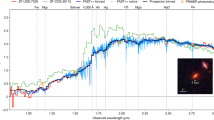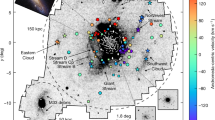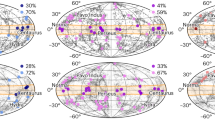Abstract
The current consensus is that galaxies begin as small density fluctuations in the early Universe and grow by in situ star formation and hierarchical merging1. Stars begin to form relatively quickly in sub-galactic-sized building blocks called haloes which are subsequently assembled into galaxies. However, exactly when this assembly takes place is a matter of some debate2,3. Here we report that the stellar masses of brightest cluster galaxies, which are the most luminous objects emitting stellar light, some 9 billion years ago are not significantly different from their stellar masses today. Brightest cluster galaxies are almost fully assembled 4-5 billion years after the Big Bang, having grown to more than 90 per cent of their final stellar mass by this time. Our data conflict with the most recent galaxy formation models4,5 based on the largest simulations of dark-matter halo development1. These models predict protracted formation of brightest cluster galaxies over a Hubble time, with only 22 per cent of the stellar mass assembled at the epoch probed by our sample. Our findings suggest a new picture in which brightest cluster galaxies experience an early period of rapid growth rather than prolonged hierarchical assembly.
This is a preview of subscription content, access via your institution
Access options
Subscribe to this journal
Receive 51 print issues and online access
$199.00 per year
only $3.90 per issue
Buy this article
- Purchase on Springer Link
- Instant access to full article PDF
Prices may be subject to local taxes which are calculated during checkout



Similar content being viewed by others
References
Springel, V. et al. Simulations of the formation, evolution and clustering of galaxies and quasars. Nature 435, 629–636 (2005)
Kampakoglou, M., Trotta, R. & Silk, J. Monolithic or hierarchical star formation? A new statistical analysis. Mon. Not. R. Astron. Soc. 384, 1414–1426 (2008)
van Dokkum, P. G. et al. Confirmation of the remarkable compactness of massive quiescent galaxies at z ≈ 2.3: early-type galaxies did not form in a simple monolithic collapse. Astrophys. J. Lett. 677, L5–L8 (2008)
De Lucia, G. & Blaizot, J. The hierarchical formation of the brightest cluster galaxies. Mon. Not. R. Astron. Soc. 375, 2–14 (2007)
Bower, R. G. et al. Breaking the hierarchy of galaxy formation. Mon. Not. R. Astron. Soc. 370, 645–655 (2006)
Vale, A. & Ostriker, J. P. A non-parametric model for linking galaxy luminosity with halo/subhalo mass: are brightest cluster galaxies special? Mon. Not. R. Astron. Soc. 383, 355–368 (2008)
Sandage, A. & Hardy, E. The redshift-distance relation. VIL absolute magnitudes of the first three ranked cluster galaxies as functions of cluster richness and Bautz-Morgan cluster type: the effect of q o . Astrophys. J. 183, 743–758 (1973)
Lauer, T. R. & Postman, M. The motion of the Local Group with respect to the 15,000 kilometer per second Abell cluster inertial frame. Astrophys. J. 425, 418–438 (1994)
Collins, C. A. & Mann, R. G. The K-band Hubble diagram for brightest cluster galaxies in X-ray clusters. Mon. Not. R. Astron. Soc. 297, 128–142 (1998)
Burke, D. J., Collins, C. A. & Mann, R. G. Cluster selection and the evolution of brightest cluster galaxies. Astrophys. J. Lett. 532, L105–L108 (2000)
Bremer, M. N. et al. XMM-LSS discovery of a z = 1.22 galaxy cluster. Mon. Not. R. Astron. Soc. 371, 1427–1434 (2006)
Stanford, S. A. et al. The XMM Cluster Survey: a massive galaxy cluster at z = 1.45. Astrophys. J. Lett. 646, L13–L16 (2006)
Rosati, P. et al. An X-ray-selected galaxy cluster at Z = 1.26. Astron. J. 118, 76–85 (1999)
Demarco, R. et al. VLT and ACS observations of RDCS J1252.9–2927: dynamical structure and galaxy populations in a massive cluster at z = 1.237. Astrophys. J. 663, 164–182 (2007)
Mullis, C. R. et al. Discovery of an X-ray-luminous galaxy cluster at z = 1.4. Astrophys. J. Lett. 623, L85–L88 (2005)
Romer, A. K., Viana, P. T. P., Liddle, A. R. & Mann, R. G. A serendipitous galaxy cluster survey with XMM: expected catalog properties and scientific applications. Astrophys. J. 547, 594–608 (2001)
Sahlén, M. et al. The XMM Cluster Survey: forecasting cosmological and cluster scaling relation parameter constraints. Preprint at 〈http://arxiv.org/abs/0802.4462〉 (2008)
Hilton, M. et al. The XMM Cluster Survey: the dynamical state of XMMXCS J2215.9–1738 at z = 1.457. Astrophys. J. 670, 1000–1009 (2007)
Stott, J. P., Edge, A. C., Smith, G. P., Swinbank, A. M. & Ebeling, H. Near-infrared evolution of brightest cluster galaxies in the most X-ray luminous clusters since z = 1. Mon. Not. R. Astron. Soc. 384, 1502–1510 (2008)
Whiley, I. M. et al. The evolution of the brightest cluster galaxies since z ≈ 1 from the ESO Distant Cluster Survey (EDisCS). Mon. Not. R. Astron. Soc. 387, 1253–1263 (2008)
Yamada, T. et al. Witnessing the hierarchical assembly of the brightest cluster galaxy in a cluster at z = 1.26. Astrophys. J. Lett. 577, L89–L92 (2002)
Eggen, O. J., Lynden-Bell, D. & Sandage, A. R. Evidence from the motions of old stars that the Galaxy collapsed. Astrophys. J. 136, 748–767 (1962)
Larson, R. B. Dynamical models for the formation and evolution of spherical galaxies. Mon. Not. R. Astron. Soc. 166, 585–616 (1974)
Binney, J. On the origin of the galaxy luminosity function. Mon. Not. R. Astron. Soc. 347, 1093–1096 (2004)
Dekel, A. et al. Cold streams in early massive hot haloes as the main mode of galaxy formation. Nature 457, 451–454 (2009)
Wake, D. A. et al. The 2df SDSS LRG and QSO survey: evolution of the luminosity function of luminous red galaxies to z = 0.6. Mon. Not. R. Astron. Soc. 372, 537–550 (2006)
Almeida, C. et al. Luminous red galaxies in hierarchical cosmologies. Mon. Not. R. Astron. Soc. 386, 2145–2160 (2008)
Lin, Y.-T. & Mohr, J. J. K-band properties of galaxy clusters and groups: brightest cluster galaxies and intracluster light. Astrophys. J. 617, 879–895 (2004)
Bruzual, G. & Charlot, S. Stellar population synthesis at the resolution of 2003. Mon. Not. R. Astron. Soc. 344, 1000–1028 (2003)
Chabrier, G. Galactic stellar and substellar initial mass function. Publ. Astron. Soc. Pacif. 115, 763–795 (2003)
Acknowledgements
This work is based in part on data collected at the Subaru Telescope, which is operated by the National Astronomical Observatory of Japan and the XMM-Newton, an ESA science mission funded by contributions from ESA member states and from NASA. We acknowledge financial support from Liverpool John Moores University and the STFC. M.H. acknowledges support from the South African National Research Foundation. IRAF is distributed by the National Optical Astronomy Observatories, which are operated by the Association of Universities for Research in Astronomy, Inc., under cooperative agreement with the National Science Foundation. We thank G. De Lucia for making simulation results available to us in tabular form, I. Tanaka for developing the MCSRED package used to reduce the MOIRCS data, M. Salaris for discussions on stellar population synthesis models and B. Maughan for discussions on cluster masses.
Author Contributions C.A.C. provided the scientific leadership, helped design the experiment, wrote the paper and led the interpretation. J.P.S. performed the photometry and data analysis and made major contributions to the interpretation. M.H. wrote the Subaru proposal, carried out the data reduction and photometric calibration, contributed to the analysis and interpretation and provided detailed comments on the manuscript. S.T.K. independently checked the cluster mass calculations. S.A.S. provided useful discussions on the data and comments on the manuscript. The remaining authors make up the team of the wider XCS project which led to the discovery of J2215. R.G.M., R.C.N., and A.K.R. made useful comments on the text.
Author information
Authors and Affiliations
Corresponding author
Supplementary information
Supplementary Information
This file contains Supplementary Data, Supplementary References, Supplementary Figures 1-4 with Legends and Supplementary Table 1 (PDF 550 kb)
Rights and permissions
About this article
Cite this article
Collins, C., Stott, J., Hilton, M. et al. Early assembly of the most massive galaxies. Nature 458, 603–606 (2009). https://doi.org/10.1038/nature07865
Received:
Accepted:
Issue Date:
DOI: https://doi.org/10.1038/nature07865
This article is cited by
-
The faint light in groups and clusters of galaxies
Nature Astronomy (2022)
-
Ten billion years of brightest cluster galaxy alignments
Nature Astronomy (2017)
-
The realm of the galaxy protoclusters
The Astronomy and Astrophysics Review (2016)
-
Early galaxies surprise with size
Nature (2009)
Comments
By submitting a comment you agree to abide by our Terms and Community Guidelines. If you find something abusive or that does not comply with our terms or guidelines please flag it as inappropriate.



